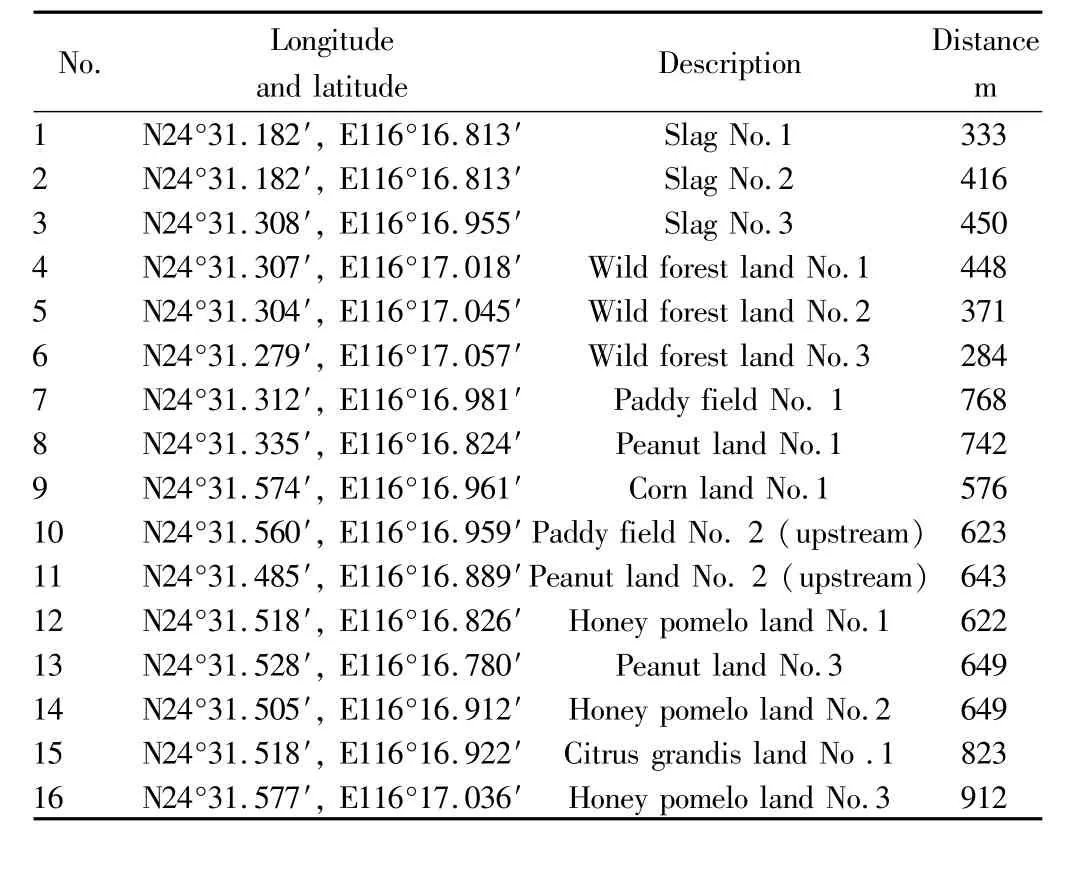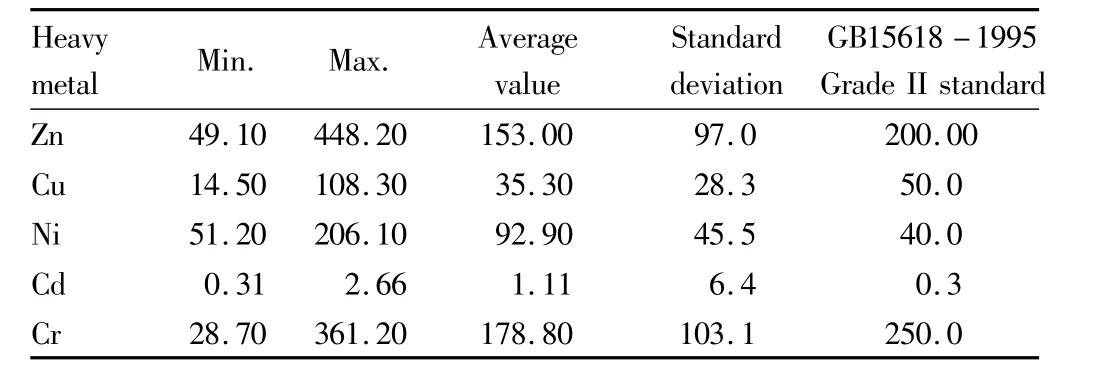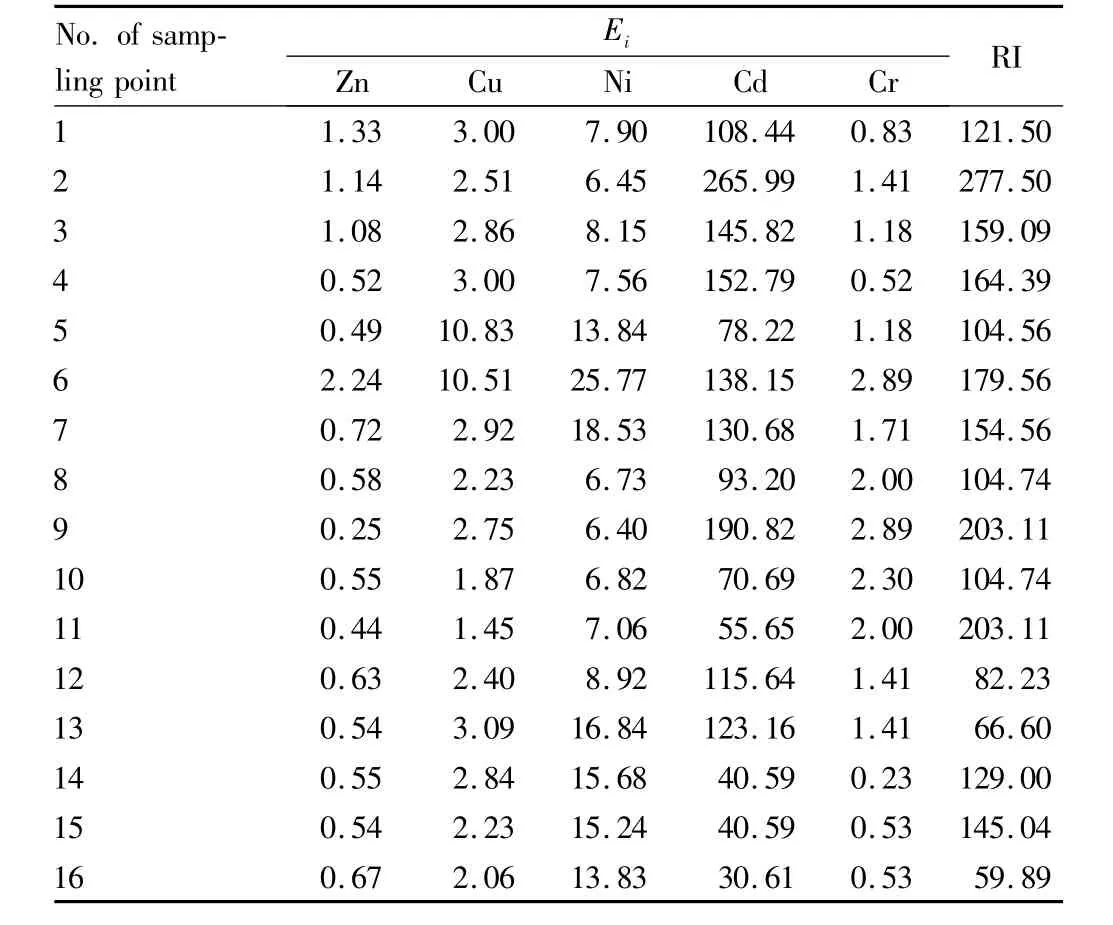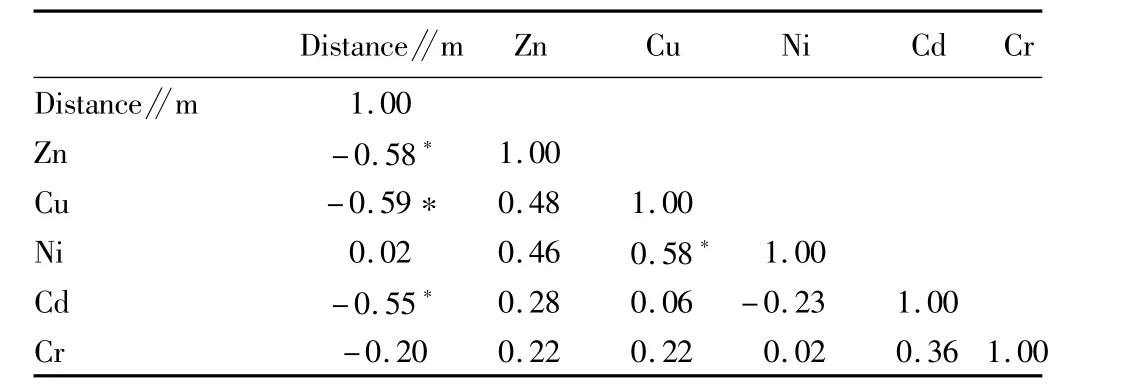Evaluation on Soil Heavy Metal Pollution around Tailing Areas:A Case Study of Ag-Sb Deposit in Northeastern Guangdong
2015-02-06DeliangLIUKaifengWANGQiheYANGQinZhu
Deliang LIU,Kaifeng WANG ,Qihe YANG,Qin Zhu
1.School of Life Sciences,Jiaying University,Meizhou 514015,China;2.School of Chemistry and Environment Sciences,Jiaying University,Meizhou 514015,China
Heavymetals are metals with atomic weight higher than 40 and specific density greater than 4 or 5.Many heavy metals are trace elements having important function for plant nutrition.Physiological functions of these elements depend on their concentration.At low concentration,elementsmay be essential elements for living of organisms,but theymay be passively absorbed and do not generate physiological function;at high concentration,they will generate toxic function to organisms.Therefore,they are often considered as toxic elements,namely,heavy metal pollution.These heavymetals include Cu,Zn,Cd,Pb,Hg,Cr,As,Ni,and Co,etc[1,2].Heavymetalsare easily accumulated in soilbutdifficultly to be decomposed by soilmicroorganism.This not only influences physical and chemical properties of soil,impedes effective supply of nutrients,restricts growth and development of plant,but also may be changed into methyl chemicals,and ultimately threatens people's health through transfer of biological chain and food chain[3,4].
Meizhou in eastern Guangdong is rich in mineral resources.There are 48 provenminerals,including coal,iron,copper,manganese,lead,zinc,silver,antimony,rare earth,limestone,granite,marble,and 530 deposits.Inmore than 10 years ofmining,solid wastes ofmines,such as open-cast,waste dump,tailing areas,and subsidence areas are major sources of soil heavy metal pollution[5].For this,we took Ag-Sb deposit tailing areas in northeastern Guangdong as study object,and evaluated content of heavymetals(Zn,Cu,Ni,Cd and Cr)and their pollution in Ag-Sb deposit tailing areas in northeastern Guangdong,in the hope of providing reference for land reclamation and ecological restoration of thismining area.
1 M aterials and methods
1.1 Collection of soil samp lesIn October 2012,considering specific terrain and hydrological conditions of this tailing area stockpiling,we set sample collection points in hillside along sewage discharge ditches and two sides.In 1km range,we set 16 sampling points in different function areas(slag area,wild forest land,paddy field,non-irrigated farmland(peanut land and corn land)),16 sampling points in orchards,including3 in slag land,3 in wild forest land,2 in paddy field,4 in non-irrigated land,and 4 in orchard,as listed in Table 1.Sampling depth is 0-15 topsoil.In 1×1m2sampling area of each sampling point,we collected 5-10 sub-samples to form amixed soil sample.

Table 1 Generation situation of samp ling points
1.2 Sam ple processing and test
1.2.1Preprocessing of samples.Put collected samples in shady and cool place for 12-13 days.After naturally dry,using quartering,we took about 2 kg samples,ground proper soil samples in agatemortar,prepared samples in 20 mesh(bore diameter 0.84 mm),80mesh(bore diameter0.200mm),and 120mesh(bore diameter 0.133 mm),and placed samples in bake oven to dry for 24 hours for use.
1.2.2Measurement of samples.After samples were digested in mixed acid HCl-HNO3-HF-HClO4,we measured concentration ofheavymetals Zn,Cu,Ni,Cd,and Cr by atomic absorption spectrometry(Shimadzu atomic absorption spectrophotometer AA-6300(P/N 206-51800)),and repeated three times of test.
1.3 Evaluation methods
1.3.1Single factor pollution indexmethod of heavymetals.We made single factor pollution evaluation of heavy metals using the following calculation formula[6]:
where Pidenotes single factor pollution index of the i-th heavy metal in soil;Ciismeasured content of the i-th heavy metal in soil;Siis evaluation standard of the i-th heavymetal.We adopted Grade IICriteria of the Standard for Soil Environmental Quality in GB15618-1995[7].
In general,the higher Pimeans the higher pollution.Pi≤1:not polluted;1<Pi≤2:mildly polluted;2<Pi≤3:moderately polluted;Pi>3:seriously polluted.

Table2 Toxic coefficient of soil heavy metals
1.3.2Ecological hazard index evaluationmethod.The potential ecological hazard indexmethod isan influentialmethod widely applied in theworld[8,9].According to researchesof Swedish scholar Hakanson,the potential ecological hazard coefficient Eiof the i-th heavymetal of single heavymetal in soil can be denoted as:
where Tiis the toxic coefficientof the heavymetal i[10],as indicated in Table 2;Piis single pollution index of the i-th metal in soil.
The potential ecologicalhazard coefficient(Ei)describes the pollution degree of a certain pollutant(element),while potential ecological hazard index(Table 3)describes the overall value of potential ecological hazard coefficient in certain point,namely,the potential ecological hazard risk index(RI)of many heavy metals in soil is the sum of potential ecological hazard coefficient(Ei)of single heavymetals:

Table3 The relation between potential ecological hazard coefficient and pollution degree of heavymetals

Table4 Content of heavy metals in soil∥mg/kg
2 Results and analyses
2.1 Heavy metals in soilWith reference to grade II standard in Standard for Soil Environmental Quality in GB15618-1995,from Table 5,we know that Cd and Ni exceed the standard,the average value of Cd(1.11mg/kg)reaches4 times the standard,themaximum value exceeds 9 times,average value of Ni(92.9 mg/kg)exceeds one time the standard,and themaximum standard exceeds 5 times.The standard deviation indicates that there is a high difference in heavymetal content in sample points.Therefore,to evaluate actual level and degree of heavymetal pollution,it is necessary tomake evaluation of different sampling points and their function areas.
2.2 Evaluation of heavymetal pollution
2.2.1Analysis of single factor pollution index of heavymetals.From Fig.1 and Table 5,there is a sharp difference(1.03-8.87)in Piof soil heavy metal Cd in all sampling points.Sampling point No.2 has the highest Pi(8.87),and sampling point No.16 has the lowest Pi(1.03),the rate of exceeding standard is 100%,number of heavymetal polluted points(Pi>3)is10 and the percentage is62.50%.Variance analysis indicates that the Pidifference of heavymetal Cd reaches the extremely significant level(P<0.01).Through Q test,as per L.S.D=Q0.01(s2/n)1/2,we obtained the minimum significance difference is 3.54.With distance increase of original ore processing shop,especially slag piling place,Cd value dropsaccordingly.Generally,change trend of heavymetal Cd in soil of different sampling points in different function areas is as follows:slag area,forest land,paddy field,non-irrigated farmland(peanut land and corn land),and orchard.
From Fig.1 and Table 5,there is a sharp difference(1.28-5.15)in Piof soil heavymetal Ni in all sampling points.Sampling point No.6 has the highest Pi(5.15),and sampling point No.9 has the lowest Pi(1.28),the rate of exceeding standard is 100%,number of heavymetal polluted points(Pi>3)is 5 and the percentage is31.25%.Variance decomposition analysis indicates that the Pidifference of soil heavymetal in sampling points reaches significant level(P<0.05),but change trend of Ni in different functions is not obvious.Other heavymetals such as Zn,Cu,and Cr have certain difference in Pi,but there is no sampling point seriously polluted(Pi>3),and the pollution is relatively mild.

Table5 Single factor pollution evaluation results of heavymetals
2.2.2Potential ecological hazard risk index.From the single factor potential ecological hazard coefficient Ei(Table 6),among 16 sampling points surveyed,2 sampling points have high Cd pollution(160≤Ei<320),sampling point No.2(265.99)and sampling point No.9(190.82);8 sampling points have higher Cd pollution(80≤Ei<160);5 sampling points havemedium Cd pollution(40≤Ei<80);and one sampling point have low Cd pollution(Ei<40).Other four heavymetals Zn,Cu,Ni and Cr are at low pollution level(Ei<40).

Table3 The potential ecological hazard coefficient(Ei)and risk index(RI)of heavy metals in soil
From total potential ecological hazard risk index(RI),as listed in Table 7,RIof all sampling points is in the range of50≤RI<300 and belongs to themedium pollution level.This is possibly because Cd pollution and pollution degree in sampling points are different.In general,RI change trend is slag land>forest land>paddy field>non-irrigated farmland>orchard.
2.3 Correlation analysis of soil heavy metal pollutionFrom Table 7,we know that there is different level of correlation between heavymetals in soil,butonly Niand Cu reach the significant level of correlation.It should be noted that because there is certain level of Ni pollution in this tailing area,the synergetic effect of Cu and Nimay deteriorate Ni pollution.
In addition,from the perspective of the distance from sampling points to original ore processing shops,there is significantly negative correlation between heavymetal Cd,Zn and Cu and the distance,indicating that soil heavymetals fallwith the increase in distance to the ore separation processing shop.Therefore,in agricultural and forestry production,to guarantee ecological security of foods,it is not appropriate to carry out production activities near the ore processing shops and slag stockpiling areas.

Table 7 Correlation of content of heavy metals in soil
3 Conclusions
Firstly,soil heavy metal pollution is mainly Cd-Ni compound pollution,including Cd content0.31-2.66mg/kg(average content is 1.11 mg/kg),and Ni content 51.2-92.9 mg/kg(average content is 92.9mg/kg).From the single factor potential ecological hazard coefficient Ei(Table6),among 16 sampling points surveyed,2 sampling points have high Cd pollution(160≤Ei<320),sampling point No.2(265.99)and sampling point No.9(190.82);8 sampling pointshave higher Cd pollution(80≤Ei<160);5 sampling points have medium Cd pollution(40≤Ei<80);and one sampling point have low Cd pollution(Ei<40).Other four heavy metals Zn,Cu,Ni and Cr are at low pollution level(Ei<40).From total potential ecological hazard risk index(RI),RIof all sampling points is in the range of 50≤RI<300 and belongs to the medium pollution level.Generally,change trend of heavymetal Cd in soil of different sampling points in different function areas is as follows:slag area>forest land>paddy field>non-irrigated farmland>orchard.
Secondly,relevant analysis indicates that in soil heavymetal content,only Ni and Cu are positively correlated.Since there is certain degree of Ni pollution in this deposit,the synergetic effect of Cu and Nimay deteriorate Ni pollution.In addition,from the perspective of the distance from sampling points to original ore processing shops,there is significantly negative correlation between heavy metal Cd,Zn and Cu and the distance,indicating that soil heavymetals fallwith the increase in distance to the ore separation processing shop.Therefore,in agricultural and forestry production,to guarantee ecological security of foods,it is not appropriate to carry out production activities near the ore processing shops and slag stockpiling areas.
[1]Del RM,FontR,Almela C,etal.Heavymetalsand arsenic uptake bywild vegetation in the Guadiamar river area after the toxic spill of the Aznalcollar mine[J].Journal of Biotechnology,2002,98(1):125-137.
[2]Karathanasis AD,Johnson CM.Metal removal potential by three aquatic plants in an acid mine drainage wetland[J].Mine Water and the Environmental,2003,22(1):22-30.
[3]DAISG.Environmental chemistry(the 2nd edition)[M].Beijing:Higher Education Press,2006:10.(in Chinese).
[4]Hossain MF.Khondaker M.Environmental contamination and seasonal variation on heavymetals in rice fields[J].Research Journal of Chemistry and Environment,2006,10(1):8-12.
[5]LIU DL.Mineral resources&development and utilization in Meizhou City[J].Journal of Jiaying University,2014,32(2):40-43.(in Chinese).
[6]LIU B.Study on the pollution ofmajor mining areas in the upstream of Dahuofang Reservoir and evaluation on its potential ecological hazard[J].Liaoning Urban and Rural Environmental Science&Technology,2013,33(7):56-58.(in Chinese).
[7]GB.Soil Environmental Quality Standards(GB 15618-1995)[S].1995-12-06.(in Chinese).
[8]LARS Hakanson.An ecological risk index for aquatic pollution control-Asedimentological approach[J].Water Research,1980(14):975-1001.
[9]CHENG F,CHENG JP,SANGHC,etal.Assessmentand correlation analysis of heavymetals pollution in soil of Dajinshan Island[J].Chinese Journal of Environmental Science,2013,34(3):1062-1066.(in Chinese).
[10]XU ZQ,NISJ,TUOXG,etal.Calculation ofheavymetals’toxicity coefficient in the evaluation of potential ecological risk index[J].Environmental Science and Technology,2008,31(2):112-115.(in Chinese).
[11]ZHANGW,GE JT.Soil contamination by heavymetals and evaluations on potential ecological risks in an antimonymine[J].Agricultural Science&Technology,2015,16(3):600-602.
杂志排行
Asian Agricultural Research的其它文章
- Risk Evaluation on Logistics Finance of Agricultural Products Based on Fuzzy-AHP Model
- An Analysis on Export Competitiveness of Vegetables from China to ASEAN
- The Influence of Agricultural Mechanization on the Development of Agricultural Economy in Chongqing City
- Forecasting and Analysis of Agricultural Product Logistics Demand in Tibet Based on Combination Forecasting Model
- Land Use Change and Driving Forces in Guangzhou City during 1996-2012
- Canonical Correlation between the Leaf Quality Indicators of"Moderate Aroma"Flue-cured Tobacco
